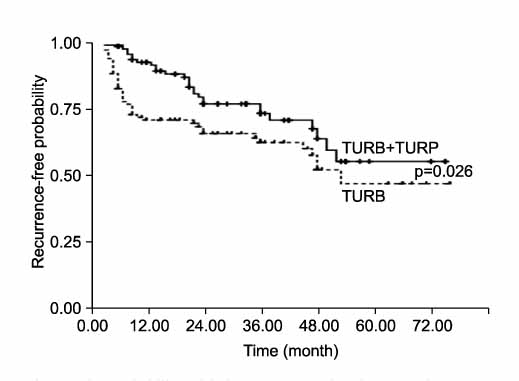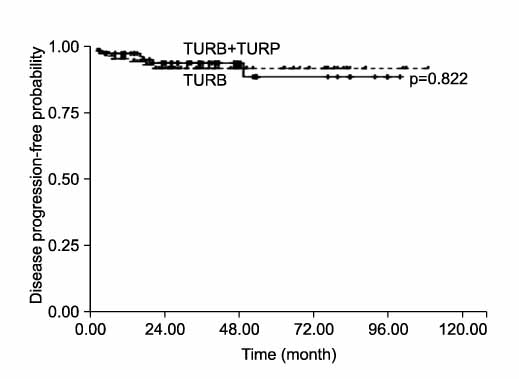Korean J Urol.
2008 Sep;49(9):791-796.
The Significance of Simultaneous Transurethral Resection of Bladder Tumor and the Prostate in Patient who have Superficial Bladder Cancer with Bladder Outlet Obstruction
- Affiliations
-
- 1Department of Urology and the Urological Science Institute, Yonsei University College of Medicine, Seoul, Korea. youngd74@yuhs.ac
Abstract
-
PURPOSE: We evaluated the clinical significance of simultaneous transurethral resection of bladder tumor(TURB) and the prostate(TURP) in patients who have superficial bladder cancer with bladder outlet obstruction.
MATERIALS AND METHODS
Between April 1997 to April 2006, 213 patients with superficial bladder cancer were included in this study. The patients were treated with TURB only(n=107, Group I) or TURB with TURP (n=106, Group II). Bladder cancer recurrence was observed by performing cystoscopy and urine cytology. Uroflowmetry was performed three months after surgery.
RESULTS
There were no significant differences in age, the tumor size or the number of tumors between groups I and II. There was no evidence of cancer implantation where TURP was applied. The recurrence rate of group II was significantly lower than that of group I(p=0.044), and the time to recurrence was longer for group II than for group I(p=0.026). There was no significant difference in the progression rate between the two groups(p=0.788). Three months after surgery, the mean residual urine volume was lower for group II(7.9ml) than that for group I(21.7ml).
CONCLUSIONS
For superficial bladder cancer patients with bladder outlet obstruction, simultaneous TURB and TURP may help reduce the bladder cancer recurrence rate and delay the time to recurrence without the risk of cancer implantation at the site where TURP is applied.
MeSH Terms
Figure
Reference
-
1. Heney NM. Natural history of superficial bladder cancer. Prognostic features and long-term disease course. Urol Clin North Am. 1992. 19:429–433.2. Lutzeyer W, Ruben H, Dahm H. Prognostic parameters in superficial bladder cancer: an analysis of 315 cases. J Urol. 1982. 127:250–252.3. Bostwick DG. Natural history of early bladder cancer. J Cell Biochem Suppl. 1992. 16I:31–38.4. Pode D, Alon Y, Horowitz AT, Vlodavsky I, Biran S. The mechanism of human bladder tumor implantation in an in vitro model. J Urol. 1986. 136:482–486.5. Rowland RG, Henneberry MO, Oyasu R, Grayhack JT. Effects of urine and continued exposure to carcinogen on progression of early neoplastic urinary bladder lesions. Cancer Res. 1980. 40:4524–4527.6. Soloway MS, Masters S. Urothelial susceptibility to tumor cell implantation: influence of cauterization. Cancer. 1980. 46:1158–1163.7. Stokle M, Alken P, Engelmann U, Jacobi GH, Riedmiller H, Hohenfellner R. Radical cystectomy--often too late? Eur Urol. 1987. 13:361–367.8. Harris AL, Neal DE. Bladder cancer--field versus clonal origin. N Engl J Med. 1992. 326:759–761.9. Hinman F. Recurrence of bladder tumors by surgical implantation. J Urol. 1956. 75:695–696.10. Kiefer JH. Bladder tumor recurrence in the urethra: a warning. J Urol. 1953. 69:652–656.11. Golomb J, Gorelik U, Keler T, Lindner A. Incidence and pattern of bladder tumor recurrence following combined suprapubic prostatectomy and excision of a bladder tumor. Eur Urol. 1989. 16:86–88.12. Greene LF, Yalowitz PA. The advisability of concomitant transurethral excision of vesical neoplasm and prostatic hyperplasia. J Urol. 1972. 107:445–447.13. Tsivian A, Shtricker A, Sidi AA. Simultaneous transurethral resection of bladder tumor and benign prostatic hyperplasia: hazardous or a safe timesaver? J Urol. 2003. 170:2241–2243.14. Vicente J, Chehile G, Pons R, Medez G. Tumor recurrence in prostatic urethra following simultaneous resection of bladder tumor and prostate. Eur Urol. 1988. 15:40–42.15. Laor E, Grabstald H, Whitmore WF. The influence of simultaneous resection of bladder tumors and prostate on the occurrence of prostatic urethral tumors. J Urol. 1981. 126:171–175.16. Eble JN, Sauter G, Epstein JI, Sesterhenn IA. World Health Organization classification of tumours: pathology and genetics of tumours of the urinary system and male genital organs. 2004. Lyon: IARC press.17. Greene FL, Page DL, Fleming ID, Fritz AG, Balch CM, Haller DG, et al. AJCC cancer staging manual. 2002. 6th ed. New York: Springer-Verlag.18. Heney NM, Ahmed S, Flanagan MJ, Frable W, Corder MP, Hafermann MD, et al. Superficial bladder cancer: progression and recurrence. J Urol. 1983. 130:1083–1086.19. Bergman A, Bhatia NN. Uroflowmetry for predicting postoperative voiding difficulties in women with stress urinary incontinence. Br J Obstet Gynaecol. 1985. 92:835–838.20. Mainprize TC, Drutz HP. Accuracy of total bladder volume and residual urine measurements: comparison between real-time ultrasonography and catheterization. Am J Obstet Gynecol. 1989. 160:1013–1016.21. Park JH. A clinical observation of the residual urine. Korean J Urol. 1972. 13:203–204.22. Kolman C, Girman CJ, Jacobsen SJ, Lieber MM. Distribution of post-void residual urine volume in randomly selected men. J Urol. 1999. 161:122–127.23. Rosier PF, de Wildt MJ, de la Rosette JJ, Debruyne FM, Wijkstra H. Analysis of maximum detrusor contraction power in relation to bladder emptying in patients with lower urinary tract symptoms and benign prostatic enlargement. J Urol. 1995. 154:2137–2142.24. Karaguzhin SG, Merinov DS, Martov AG. One-stage transurethral resection of the urinary bladder and the prostate in patients with superficial cancer of the urinary bladder combined with benign prostatic hyperplasia. Urologiia. 2005. 5:17–21.25. Jonasson O, Long L, Roberts S, McGrew E, McDonald JH. Cancer cells in the circulating blood during operative management of genitourinary tumors. J Urol. 1961. 85:1–12.26. Weyrauch HM, Crossfield JH. Dissemination of bladder neoplasms by endoscopic electroresection. J Urol. 1962. 87:391–397.27. El-Abbady AA, Shoukry MS, Hanno AG, Younis LK, Abdel-Rahman M. Repeated transurethral resection of recurrent superficial bladder tumors -- Does it affect the spread and stage of the tumor? Scand J Urol Nephrol. 2002. 36:60–64.28. Mydlo JH, Weinstein R, Shah S, Solliday M, Macchia RJ. Long-term consequences from bladder perforation and/or violation in the presence of transitional cell carcinoma: results of a small series and a review of the literature. J Urol. 1999. 161:1128–1132.29. Hudson MA, Ratliff TL, Gillen DP, Haaff EO, Dresner SM, Catalona WJ. Single course versus maintenance bacillus Calmette-Guerin therapy for superficial bladder tumors: a prospective, randomized trial. J Urol. 1987. 138:295–298.30. Mitsumori K, Tsuchiya N, Habuchi T, Li Z, Akao T, Ohyama C, et al. Early and large-dose intravesical instillation of epirubicin to prevent superficial bladder carcinoma recurrence after transurethral resection. BJU Int. 2004. 94:317–321.
- Full Text Links
- Actions
-
Cited
- CITED
-
- Close
- Share
- Similar articles
-
- Sudden hypothermia after bladder perforation during transurethral bladder tumor resection: A case report
- Intraoperative ventilation and hemodynamic change due to bladder perforation during transurethral resection of a bladder tumor: A case report
- Correlation Among Symptom Score, Peak Urine Flow, Prostate Volume and Obstructive Parameters as analyzed in Pressure-Flow Studies for the Patients wth Benign Prostate Hyperplasia in Whom TURP will be Contemplated
- The Correlation between Ultrasonic Prameters of the Prostate and the Bladder Outlet Obstruction in BPH Patients
- Effects of Simultaneous Transurethral Resection of Non-Muscle-Invasive Bladder Cancer and Benign Prostatic Hyperplasia



